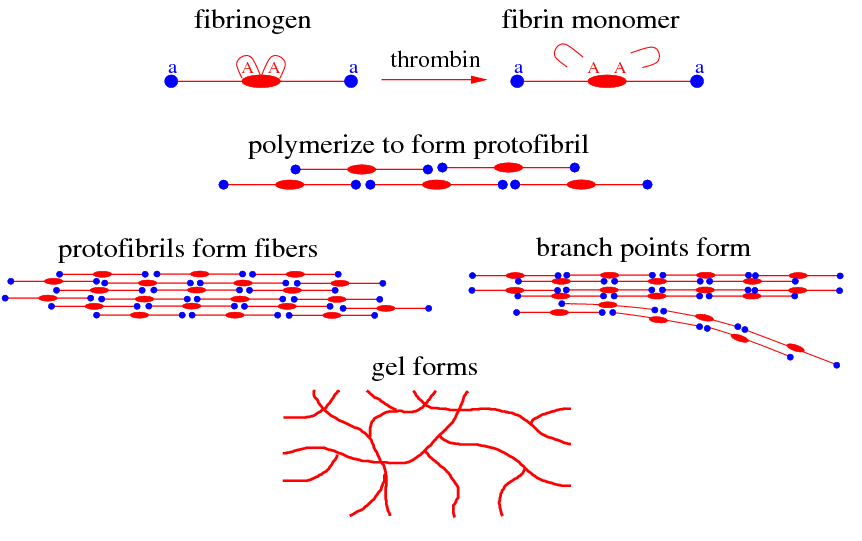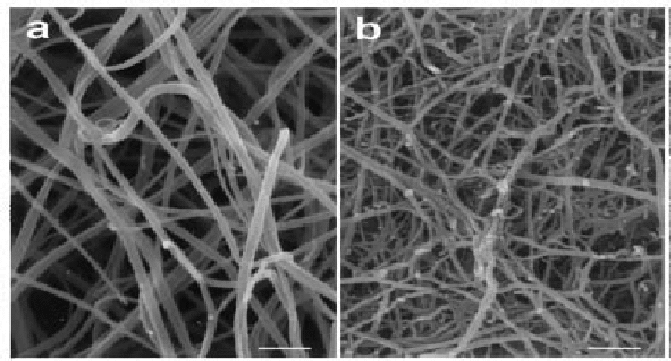Physiological Gels Research Group
Fibrin Formation
The formation of a fibrin gel is a major component of the blood clotting response. This gel, along with aggregating platelets and trapped red and white blood cells, make up the mass of a clot.
The fibrin monomers from which the gel is built are produced by the action of the coagulation enzyme on the soluble protein fibrinogen which is found in the blood plasma. Thrombin removes short peptide strands from the central region of the fibrinogen molecule to reveal binding sites that can bind to constitutively-expressed complimentary sites at the ends of another fibrin(ogen) molecule. Fibrin monomers spontaneously join together into long half-staggered strands called protofibrils. When sufficiently long, protofibrils can bind side-by-side with one another to form thicker fibrin strands. Somewhere during the formation of the protofibrils or their lateral assembly into thicker fibers branches form, and a three-dimensional protein network results. The eventual structure of the fibrin gel is kinetically determined; for example, it depends on the concentration of the enzyme thrombin which presumably affects the rate of supply of monomers to the polymerization process. The mechanical properties of the gel and the facility with which it can be broken down by the fibrinolysis process (see below) are affected by its structure and also correlate with bleeding or thrombosis problems.
Fluid dynamics also plays a significant role during fibrin gel formation. For example, clots formed under the fast flows prevalent in the arteries are made up predominantly of platelets with little fibrin while those formed under the slower flows prevalent in the veins contain relatively few platelets and relatively much fibrin.
The fibrinolysis process is an enzyme-mediated process by which a fibrin gel is broken down. Under physiological conditions, fibrin formation and fibrinolysis compete to determine the extent of fibrin gel formation. The fibrinolytic process is initiated therapeutically as a means to break down an intravascular clot that has caused a heart attack.
We are using mathematical modeling and computer simulation to explore both the formation and the breakdown of fibrin gels. Some of this work is described in the following papers:
Publications on Fibrin formation and degradation
V. Camacho, A. L. Fogelson, and J. P. Keener, Eulerian-Lagrangian treatment of non-dilute two-phase gels, SIAM J. Appl. Math., 76 (2016), 341—367.
A. L. Fogelson and J. P. Keener, A Framework for Exploring the Post-gelation Behavior of Ziff and Stell's Polymerization Models, SIAM Journal on Applied Mathematics, 75-3 (2015), 1346—1368.
Aaron Fogelson and James Keener, Toward an understanding of fibrin branching structure, Physical Review E, 81 (2010), doi: 10.1103/PhysRevE81.051922.
Robert Guy, Aaron Fogelson, James Keener, Fibrin gel formation in a shear flow, Mathematical Medicine and Biology, 24 (2007), 111—130.
Some of our work on other aspects of blood clotting is described in:
B. E. Bannish, J. P. Keener, M. Woodbury, J. Weisel and A. L. Fogelson, Modelling Fibrinolysis: 1-D Continuum Models, Mathematical Medicine and Biology, 31 (2014), 45—64.
B. E. Bannish, J. P. Keener, and A. L. Fogelson, Modelling Fibrinolysis: A 3-Dimensional Stochastic Multiscale Model, Mathematical Medicine and Biology, 31 (2014), 17—44.
Karin Leiderman and Aaron Fogelson, Grow with the Flow: A spatial-temporal model of coagulation and platelet deposition under flow, Mathematical Medicine and Biology, (2010).
Aaron Fogelson and Robert Guy, Immersed-Boundary-Type Models of Intravascular Platelet Aggregation, Computer Methods in Applied Mechanics and Engineering, 197 (2008), 2087—2104.
Aaron Fogelson and Robert Guy, Platelet-Wall Interactions in Continuum Models of Platelet Aggregation: Formulation and Numerical Solution, Mathematical Biology and Medicine, 21 (2004), 293—334.
Andrew Kuharsky and Aaron Fogelson, Surface-mediated Control of Blood Coagulation: The Role of Binding Site Densities and Platelet Deposition Biophysical Journal, 80 (2001), 1050—1074.



